|
Ms. Emi Morishita and her kids Raito, elder brother and the 3rd grader of junior high school, and Erina, younger sister and the 6th grader of elementary school, have been spending “childhood life” going out almost every weekend to have some experiences since their infancy (or sometimes with her husband, in a family of 4 members). In such a time, she attaches great importance to providing the kids with full experiences while they enjoy the given opportunities and environments freely. On the other hand, she has been setting great value on an approach of observing the reaction of the kids carefully and deciding what to do next. Emi, the mother mentions her consistent stance of childcare that she describes “characteristic”.
Since Raito entered elementary school, he has been worrying about “dysgraphia”, which causes difficulty in “writing” characters or sentences. However, Emi has always been positive in repeating trial and error to find out the best solution. As part of it, 6 years ago when she and her family lived in a local city far from Tokyo due to her husband’s job, she found on the Internet “Junior Software Seminar” hosted by FORUM8, a seminar for young children using FORUM8’s 3D real-time VR software “UC-win/Road”, and took part in it with Raito, who was the 3rd-grader of elementary school. After the following year, Erina, who became the 1st grader of elementary school, also joined them. Since then, 2 kids have been joining the Seminar every year.
Struggle with Dysgraphia while Trying to Touch with Nature
“Partly because my husband and I love nature, both kids (brother and sister) have been visiting sea every week since they were small. It can be said that they have grown up in nature.”
When the family lived in a heartland city close to the seashore and full of nature, Emi used to take both kids to the shore for play since before each of them reached one year old. Meanwhile, different individuality between them were raised up gradually. For example, the brother was absorbed in making structures such as a waterway with sand, and the sister had a special interest in living creatures. Emi has also been watching over them collaborating with each other occasionally.
However, after Raito entered local elementary school, one of his aspects of “being poor at writing characters”, which Emi had been anxious about from before, became obvious. About half a year later, as the amount of handwriting on the notebook increased, he couldn’t catch up with the writing speed and characters got complicated. Especially, since he became unable to take notes for the correspondence notebook between the class teacher and parents, he was allowed to use a supplementary digital camera after negotiation with the school. This was the first crisis he somehow managed to cope with.
However, when he moved up to the second grade, a new teacher in charge of his class put more importance on the equality of means. Partly because the level of social understanding of dysgraphia was lower than today, circumstances made a complete change. Not only use of the digital camera that had been allowed before but also every alternative measure was rejected. In addition, symptoms of dysgraphia vary greatly between individuals. In case of Raito, he can write letters by hand a little if he writes slowly, sometimes being apt to be misunderstood that he can actually write letters. Scolded at school occasionally, Raito began to suffer from day-to-day disorder of his mental and physical condition out of stress. In trial and error, Emi started to teach him operation of the personal computer with the Roman alphabet input method, which is considered to be easier to accept physiologically than kana input.
On the other hand, although there were few cases of dysgraphia in the region, Emi believed that there must be a certain number of kids having the similar trouble at the national level, and negotiated with school and the prefecture tenaciously. Following this, the prefecture accessed National Institute of Special Needs Education (NISE) and found no effective countermeasure cases using conventional paper and writing tools. The only case they found was a report to show connection of a leading-edge electronic blackboard of that time and a tablet was effective. In the autumn of that year, Raito and his parents had discussion with the school to get permission to use a supplementary tablet. When the problems on the side of school were gradually solved, the class teacher took leave. Partly because the next instructor was familiar with ICT (information and communication technology), he was at last allowed to bring a tablet to school with him from the latter half of the 2nd grade.
Raite moved to another public school in Tokyo when he became 4th grader due to job relocation of his father. He was also allowed to use the tablet successively there. However, when he was 5th grader or so, the number of characters to write for composition increased substantially. Therefore, he worked on homework using PC at home. When they consulted with school about using PC at school, he was also allowed to use PC as well, limited to the one kept in the school after explaining his situations to all of the students and guardians of the same grade. Although it became easier to gain special arrangement from school than before, there were also various limitations as before. Moreover, Raito sometimes had difficulty in going to school.
Because of this, Emi started to look for junior high school respecting Raito’s will. As the private school where Raito is learning now was decided by his strong request, he is leading a student life in the environment that fits him.
On the other hand, Erina, who entered elementary school in Tokyo, was lucky enough to have many good friends in the new environment. She is behaving actively just as similarly to her childhood in the countryside seeking for nature.
Participating Various Lectures and Activities as “Seeds of Experience” of Children
“I think the best advantage of living in Tokyo is to be able to experience various new things.”
After they returned to Tokyo, two kids took part in a large number of lectures and activities trapped in the antenna Emi set up under the policy of “sowing a plenty of seeds of experiences” for the children, taking advantage of convenient transportation. These ranged over various genres. Watching over them, she took longer time to those genres in which they showed stronger reactions. As such, she shifted the way of raising children. According to Emi, as Erina acted with her brother, she had opportunities of experiencing wide and specialized activities since she was the lower grader of elementary school.
One of these activities is “Junior Doctor Training Course” by Japan Science and Technology Agency (JST). This course aims at training human resources leading scientific and technical innovation through learning the fields of science, mathematics, and information for elementary and junior high school students. As Raito was strongly interested in it when he was turning to the 5th grader, Emi had him apply for the course with Erina, both of whom were selected for taking the course of lectures. Raito has been working on the study activity for 2 years, and Erina for 1 year.
Raito also devoted himself to programing when he was the 2nd grader of elementary school and tended to become ill, with a book given by a friend of Emi as a trigger. From the 4th grade, he started to go to school to learn programming, and Erina joined there 2 years ago to learn together. Under this influence, when the pre-contest of “Robocon (Robot Contest) for Elementary School Pupils” (2018) was held, the 6th grader Raito applied for the contest and acted as its member. In addition, also when he was the 6th grader, he passed as the member of Masason Foundation invited by the Foundation. Moreover, in 2019 when he was the 1st grader of junior high school, he was also adopted to “Science Mentor Program” hosted by the Japan Science Society (JSS) by passing the selection standard equal to high school students. Like this, although Raito often had difficulty in attending elementary school, as he was led by Emi who tries anything, he has been pioneering diverse opportunities to show him potential positively.
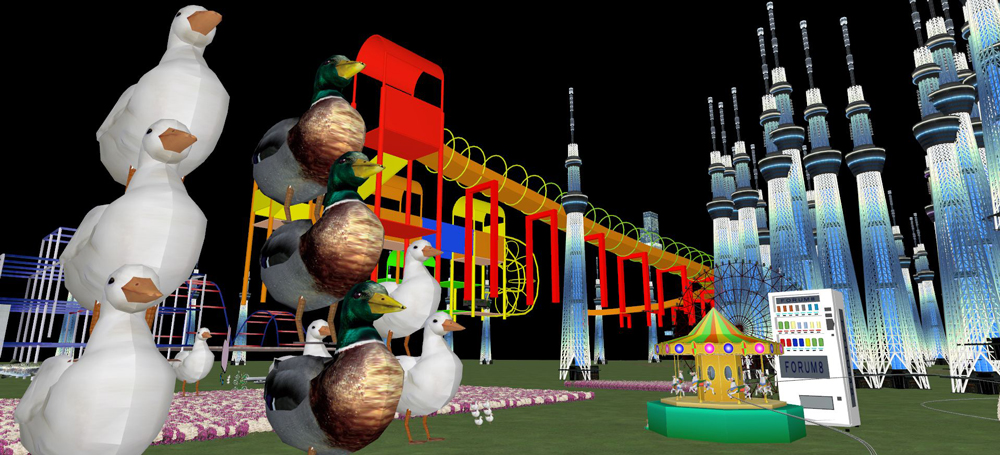 |
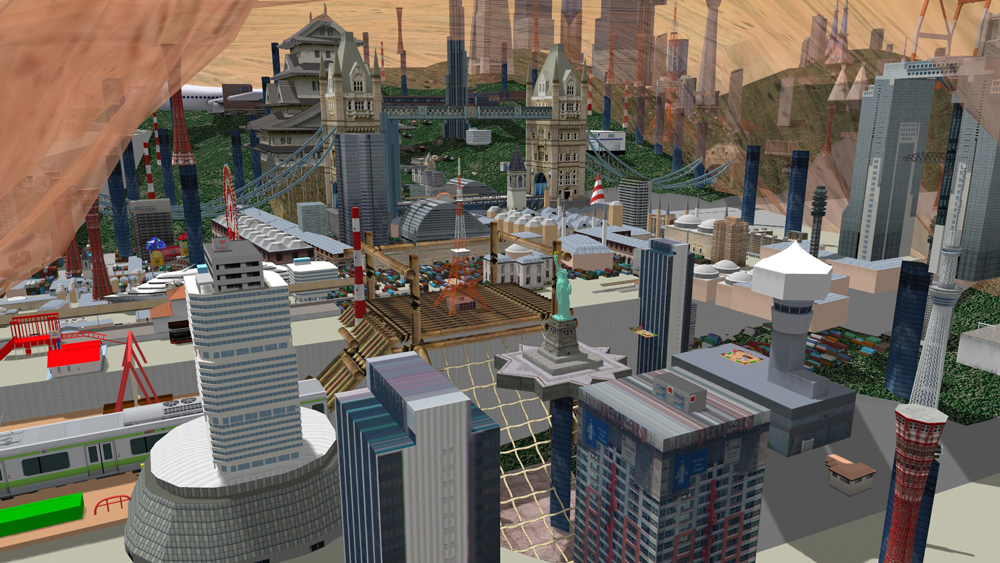 |
Work by Erina in 2020 “Tokyo Sky Tree and Secret
Amusement Park” (left) / Raito’s work in 2021
“Town Protected by Rock” (right) |
Expanding Potential after Participating in “Junior Software Seminar”
It was 2015 when Morishita family came up with “Junior Software Seminar” hosted by Forum8. It dates back to when Raito was the 3rd grader of elementary school in the countryside town.
Emi was considering what to do with her kids in the summer vacation, searching for “railroad”, which is the favorite of Raito who can recognize which train it is only by hearing the sound, or “programing” that he is good at as the keywords. Then she came up with the FORUM8’s plan that says, “Let’s create virtual three-dimensional (3D) space”. As she wondered if its contents were designed for older kids, she made inquiry and found no problem. She was pleased thinking “we can try VR”, and went to Tokyo with Raito, leaving Erina at her parents. They took part in the seminar for several days.
|
|
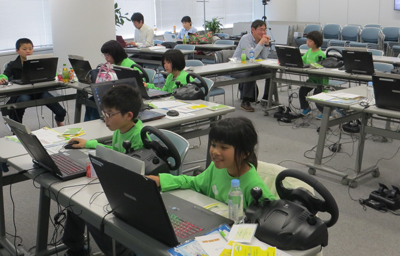 |
| Junior Software Seminar when they started to attend |
In the seminar, first of all, simple procedure of creating a 3D space using UC-win/Road was explained to provide an experience of creation actually with PC. Then the kids set up their own assignment and created 3D models. Raito describes the impression of this seminar, though it was the first time for him to experience VR, saying "it was a lot of fun as I could draw things such as a building easily and place them (within the 3D space)."
In those days, Raito was in the mid of “map boom”, devoting himself to maps and junctions. In this sense also, the seminar contained everything he loved. Because of this, rather than recovering investment or care for the results, she thinks it was good for them to try with thought “if he enjoys it without getting hurt, it is OK”, and “I just want to raise the experience value of the kids.”
As she noticed that more pupils of lower grades participated in the seminar than she expected, Emi also took Erina with Raito from the next year to attend the seminar when she became the 1st grader. Through the first seminar experience, Erina described the 3D space as “a lot of fun because I can create it freely by myself.” Since then, three of them have been participating the seminar every year in a row. In repeating participation in the seminar, Raito gradually deepened the fields in which he has a great interest such as roads, intersections with signal control, and railroads. In addition, he expresses his original world vision. For example, he constructs infrastructure such as a town and a grade separation, or a museum within a rock, a large-sized facility, a large ship, and a large automobile. In contrast, Erina represents 3D space that suggests her childhood memory of seashore such as nature, living creatures, or a city built over the water. Both of them develop original style respectively.
|
|
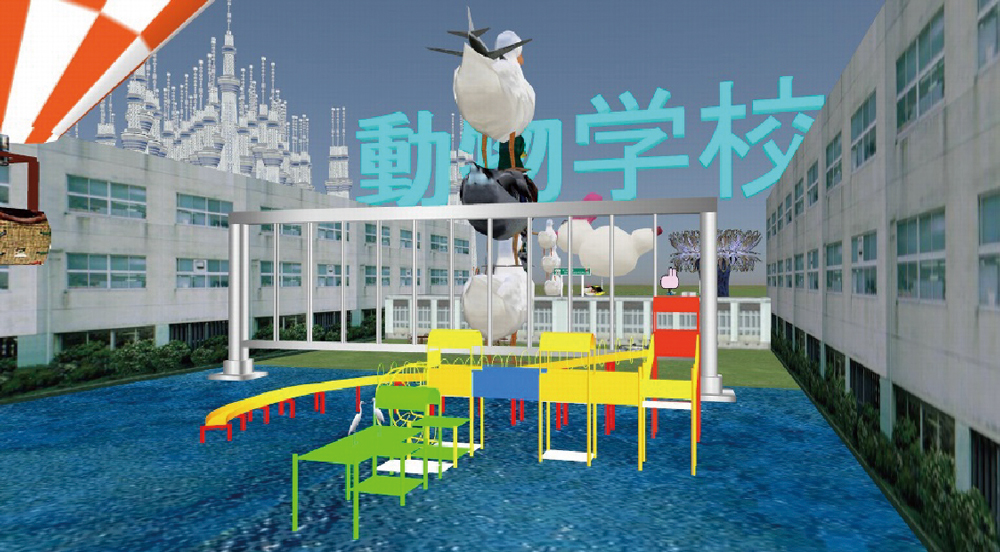 |
| Erina’s work “Animal School” |
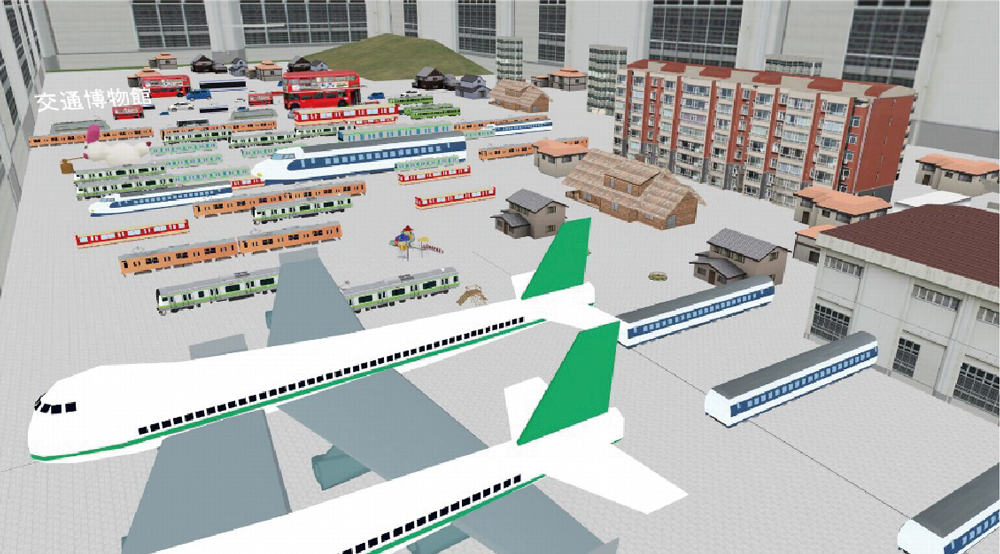 |
| Raito’s work |
Raito’s work “Town with Transportation Museum |
“In this seminar, I was surprised that kids are allowed to use the real UC-win/Road that professional engineers use.” Emi, who has a lot of experiences in taking courses for children, explains part of the characteristics of the seminar. Kids gain confidence by using it to create what they want to create with joy. She also evaluates that kids in the lower grades of elementary school were able to understand what VR is like and how it is created through the seminar. In addition, excellent works out of the VR works created in the seminar were honored in the “Design Festival” held in November every year. The valuable experience of being praised in a corner of a large event in front of many visitors encouraged Raito greatly, who was losing self-confidence at the beginning, according to Emi. |
|
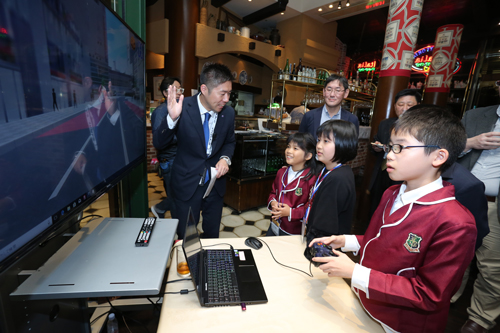 |
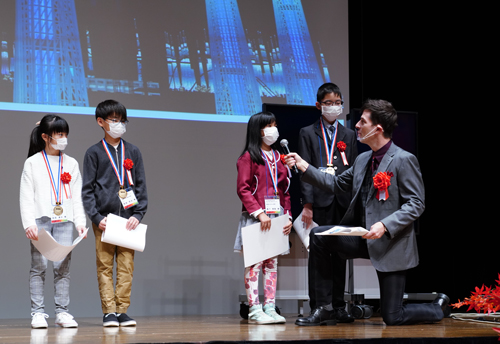 |
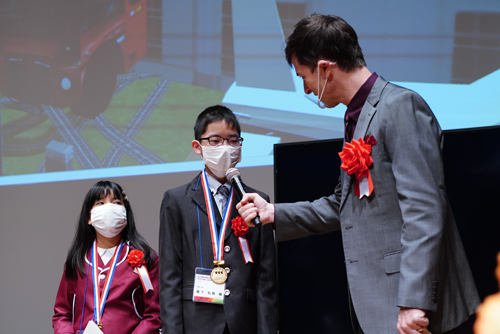 |
| Prize-awarding ceremony was held at Shinagawa Inter City Hall in November 2020, with Pakkun Interviewing the two who received Grand Prize |
Influences of the Seminar can be Advantageous for Junior High Entrance Exam
“In the future, I want to get a job related to VR and programming,” says Raito. Actually, before that, he mentions to his dream of publishing a book about dysgraphia after he enters a senior high school. He has acquired self-confidence of a new dimension in himself through the experiences of the seminar, and wishes to help people, who possibly suffer like him, by promoting understanding about dysgraphia throughout the society.
On the other hand, Erina describes her goal of “studying English hard”. In the prize-awarding ceremony for the seminar mentioned above, the scene that university students make presentation in English prompted her to think so. She hopes to place weight on such environment in determining junior-high school to enter in the near future.
Emi says that in the sense of taking the entrance exam of junior high schools, in the recent years, it seems junior high schools tend to emphasize the pupils’ learning records through 6 years of elementary schools, along with their fundamental academic abilities. In fact, for example, prize winning in the said seminar is admitted as the credit in some schools. She expects that in the future, there will be more cases that the record of taking the seminar or prize-winning in it will be taken account of the entrance exams.
“I think it would be nice to try and see what it is like, rather than adopting a cautious attitude (because it‘s VR seminar).” In fact, Erina enjoyed the process of creating what she wanted to make freely in the 3D space when she was a 1st grader of elementary school, though it was considered too early at her age. Emi also states that steady improvement in the skill of VR creation should lead kids to gain confidence.
|
